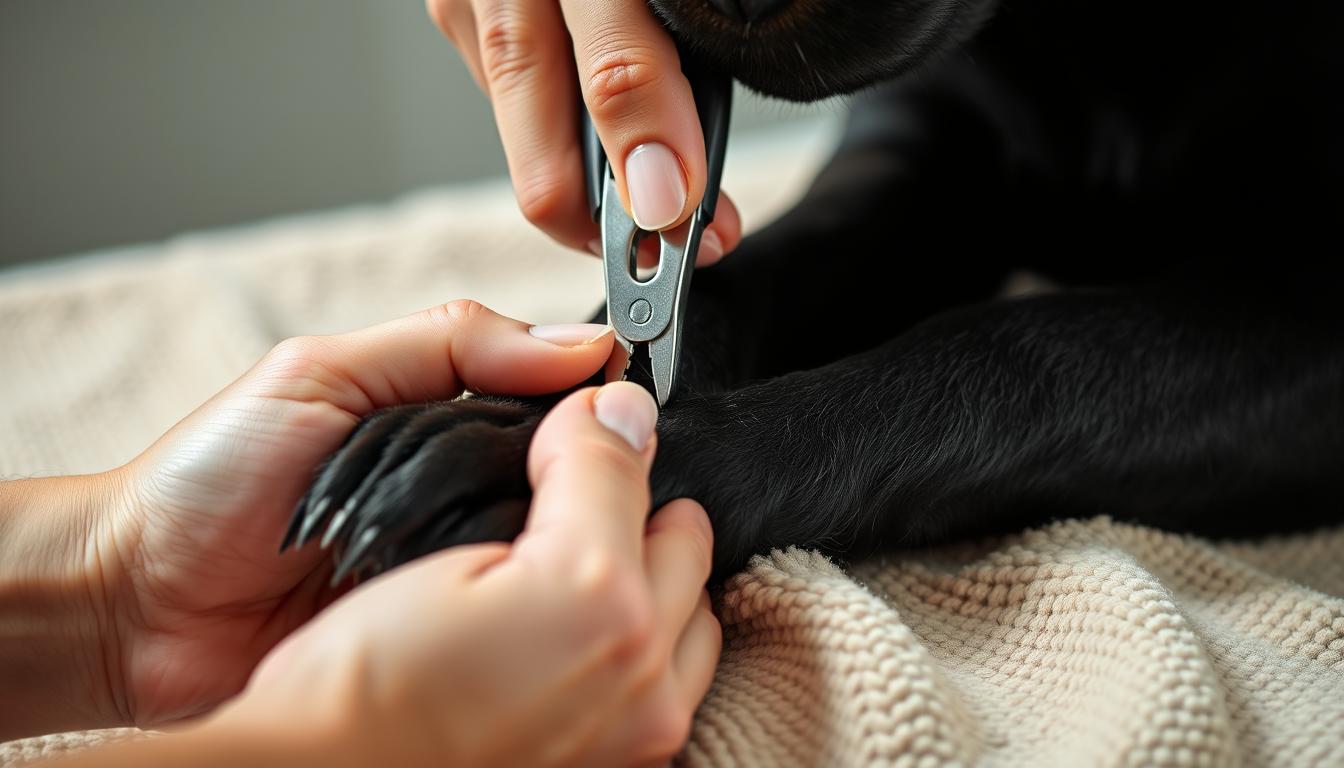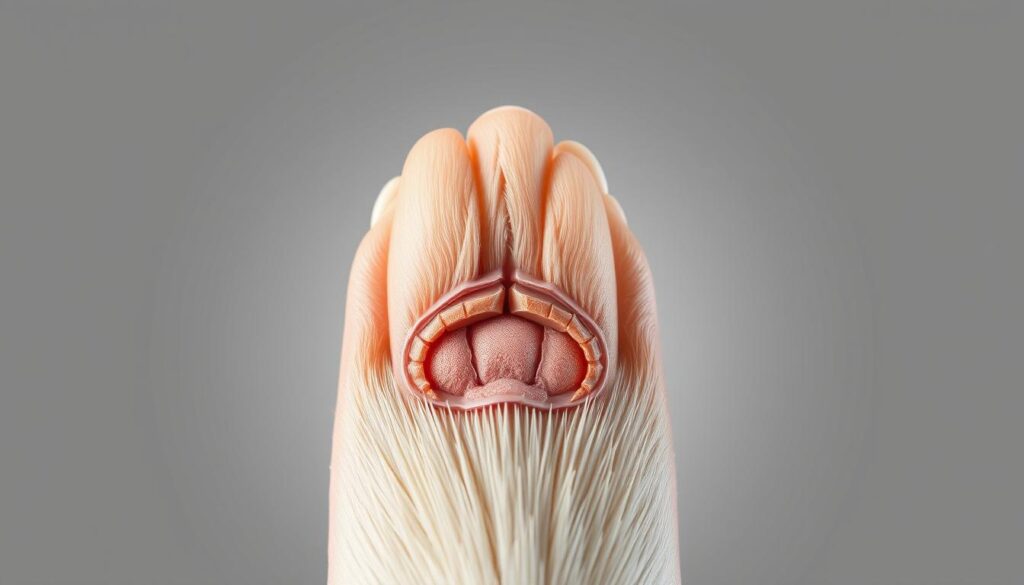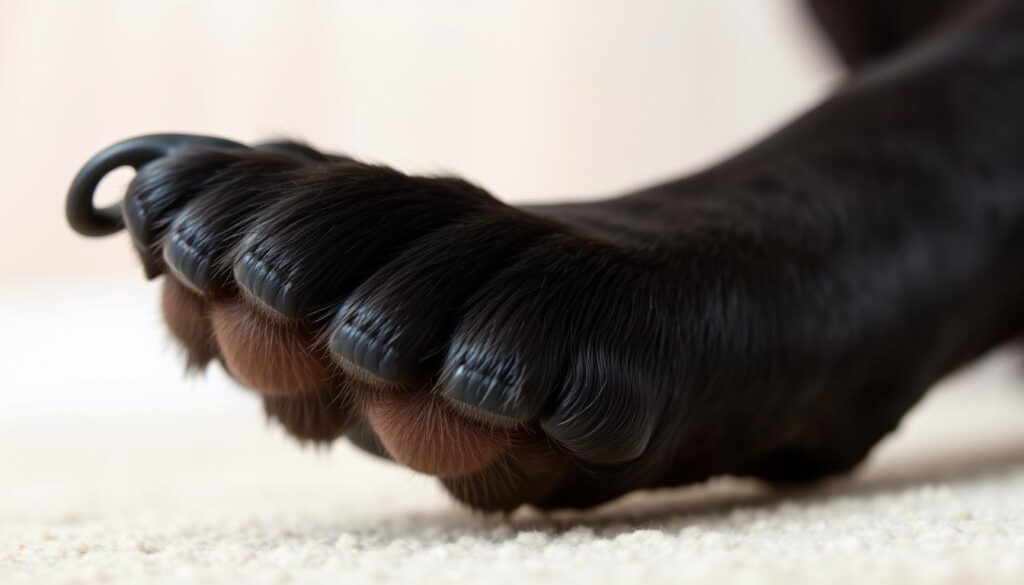
What if avoiding one simple task could save your pet from hidden pain? Many owners dread nail care for their furry companions, especially when dealing with dark-colored claws. Yet neglecting this routine can lead to cracked nails, joint strain, and even posture issues over time.
Regular maintenance keeps paws healthy and prevents the quick—the sensitive tissue inside claws—from growing too close to the tip. With lighter nails, the pinkish quick is visible, but darker ones require extra care. Monthly sessions after baths work best, as warm water softens the keratin for smoother trimming.
Building trust through gradual training helps pets stay calm. Start by handling their paws during cuddle time, then introduce clippers without cutting. Pair each session with treats and praise to create positive associations. Consistency matters more than perfection.
Key Takeaways
- Overgrown claws impact mobility and cause discomfort
- The quick contains blood vessels and requires careful avoidance
- Dark-colored nails demand precision due to limited visibility
- Monthly trimming maintains optimal nail length and quick position
- Positive reinforcement reduces stress for pets and owners
Essential Preparations for a Successful Nail Trim

Successful grooming starts long before the clippers come out. Knowing your pet’s claw structure prevents accidents and builds confidence. Each nail has three layers: a protective outer shell, a middle layer, and the quick at the center. This inner area holds blood vessels and nerves, making it crucial to avoid during trimming.
Decoding Paw Architecture
Dew claws—the higher-set nails on some paws—require special attention. The quick tapers toward the nail tip, appearing as a faint shadow in dark claws. Regular trims cause it to recede, creating a safer margin for future sessions.
Building Trust Through Routine
Introduce paw handling during relaxed moments. Start with gentle touches, then progress to holding each toe. Pair every interaction with high-value dog treats and verbal praise. This creates lasting positive associations with grooming activities.
Use a rubber mat to prevent slipping during sessions. Gather clippers, styptic powder, and rewards beforehand. {{the}}, frequent practice sessions work better than marathon attempts. Watch for signs of stress like panting or pulled-away paws.
How to Cut Black Dog Nails

Have you ever hesitated before trimming your pet’s dark claws, fearing accidental injury? This common concern stems from the hidden quick—the living tissue within each claw. Unlike lighter nails, dark keratin obscures this sensitive area, demanding specialized observation methods.
Deciphering Hidden Anatomy
Examine the claw’s underside after each tiny trim. A pale, chalky center indicates safe cutting territory. As you approach the quick, this area darkens to a grayish hue. Pro tip: Shine a phone flashlight through the claw’s side—the quick often appears as a faint shadow when backlit.
The Art of Precision Trimming
Remove 1/16-inch slivers using sharp clippers, angling away from the paw. Check the freshly cut surface after each snip. “Three small clips are safer than one risky slice,” notes professional groomer Lisa Yang. If the center turns pinkish-white, pause immediately—you’re nearing sensitive tissue.
Dull tools crush rather than slice, making color changes harder to spot. Wipe clipper blades between trims for clear visibility. For extremely dark claws, focus on removing only the curved hook rather than shortening the entire nail.
Tools, Techniques, and Safety Measures for Trimming
Proper equipment transforms nail care from stressful to systematic. Guillotine-style clippers work best for standard claws, using a hole-guided blade for controlled trimming. Scissor-type models offer surgical precision for thick or irregular nails. Both require sharp blades to prevent crushing.
Choosing the Right Nail Clippers or Grinders
Electric grinders file nails gradually, ideal for pets who fear sudden movements. “Rotary tools reduce accidental over-cutting,” explains groomer Marty Simmons. Introduce grinders slowly—let your pet inspect the device while off, then practice short sessions with treats.
Step-by-Step Trimming Process
Secure your companion using a non-slip mat. Hold each toe firmly but gently. Trim 1/16-inch slices at a 45-degree angle, stopping when the center shows a chalky white circle. Keep styptic powder nearby for unexpected bleeding.
Reward calm behavior with high-value snacks after every successful clip. Focus on removing the curved hook first—this prevents overgrown nails from catching on surfaces. Regular maintenance keeps the quick safely recessed.
Overcoming Common Challenges in Dog Nail Trimming
Many pets show resistance during grooming due to unfamiliar tools or past discomfort. Addressing these hurdles requires tailored strategies that prioritize comfort and safety.
Managing Fear and Anxiety During the Process
Begin by placing clippers near your pet during mealtimes. Let them sniff the tools while offering high-value rewards. Over 3-5 days, progress to gently touching their paws with the closed clippers.
Pair every interaction with praise and treats. If stress signs appear, pause and resume later. Consistency builds trust—short daily sessions work better than occasional attempts.
Handling Overgrown Nails and Dew Claws
Neglected claws require weekly 1/16-inch trims. This gradual approach lets the quick retreat naturally. Focus on removing the curved tip first to prevent snags.
Check dew claws monthly—these thumb-like nails on the inner leg curl dangerously if ignored. Trim them straight across, avoiding the hidden quick.
| Aspect | Regular Maintenance | Overgrown Nails |
|---|---|---|
| Trimming Frequency | Every 3-4 weeks | Weekly sessions |
| Quick Position | 1/8″ from tip | Extends near curve |
| Technique | Full trim | Hook removal only |
For severe cases, consult a groomer or vet. They can demonstrate safe methods while keeping your companion calm. Remember—progress matters more than perfection.
Conclusion
Your companion’s paw care routine becomes manageable with consistent practice and anatomical awareness. Monthly checks paired with gradual trimming prevent overgrowth while protecting sensitive tissues like blood vessels and nerves. Older pets or those with limited activity often need more frequent attention to maintain comfortable mobility.
Quality tools—from precision clippers to rotary grinders—help achieve clean results without stress. Focus on removing small portions of the curved tip during each session, especially with darker claws where internal structures remain hidden. This approach minimizes risks while keeping paws functional.
Building positive experiences through treats and calm interactions transforms grooming into bonding time. If nails curve into pads or show signs of infection, consult your veterinarian immediately. Sedation may be necessary for severe cases to ensure safe treatment.
Regular maintenance preserves your pet’s comfort and prevents long-term joint issues. With patience and the techniques outlined here, you’ll create a stress-free routine that benefits both you and your furry friend.
